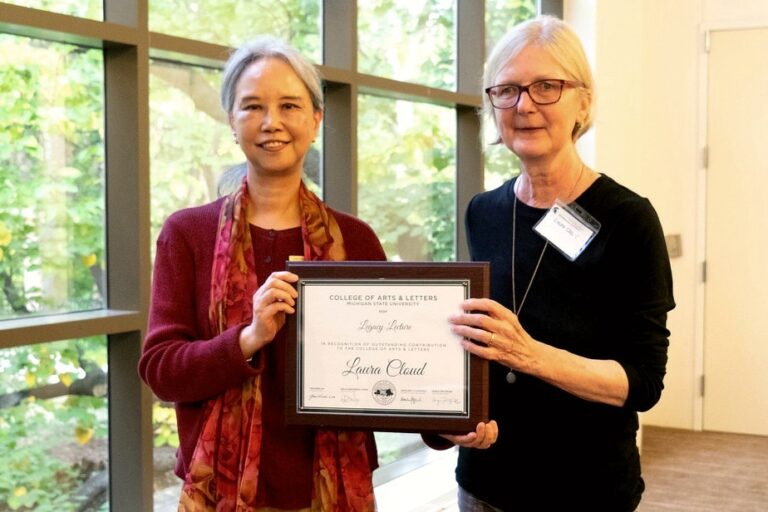Hadara Willis, a Studio Art major at Michigan State University, is one of 13 MSU students to receive a 2023 CREATE! Micro-Grant. She used this funding and her painting skills to produce a piece of art that highlights the Black female body and represents the overlaps between race and feminine beauty.
Offered by MSU’s College of Arts & Letters and facilitated by the Dean’s Arts Advisory Council with support from the MSU Federal Credit Union and departments across the university, the CREATE! Micro-Grant program encourages Michigan State University students to critically engage, through art, with the past, present, or future while offering them the opportunity to explore current events and issues through mediums such as art, dance, film, poetry, and song.

Students are given $500 to produce their proposed projects, which are later showcased in the program’s online exhibition.
Willis’s work explores the modern Western female standards with historical and contemporary imagery in her painting.
“The imagery included is representative of the evolution of Western acceptance and prejudices of the Black body’s existence within the sphere of the ideal feminine context,” Willis said. “I chose to use paint as the primary medium for this piece as a way to reflect on and juxtapose the historical references of women in art, particularly the Black female body, which was generally excluded from these spaces and conversations or depicted in a primitivistic light.”
“I am depicting the Black female body in a space it has typically been excluded from, in a way that calls upon historical and modern contexts/standards and issues, in a way that returns autonomy and respect to the figure.”
Willis is using plants in the piece as a form that can relate to women’s bodies.
“Plants are included as an ironic motif, overlapping with the female figure, to represent the duality between the ideal feminine form as something to be admired and cultivated, and also as an object for consumption,” Willis said. “The inclusion of plants as a visual motif also calls upon the history of primitivism, both within the art world and outside of it.”

However, Willis said that she couldn’t let the florals overtake the painting completely since she wanted the focal point to be on the community that has been “historically silenced.”
Through this project, Willis addresses the overarching issue in regard to race and beauty.
“I am depicting the Black female body in a space it has typically been excluded from,” Willis said, “in a way that calls upon historical and modern contexts/standards and issues, in a way that returns autonomy and respect to the figure.”
“I use my art practice as an outlet and as a conversation starter for issues or experiences that relate to me, and those that I relate to. It helps to document the still present stressors and issues that continue to plague our society, and it shows that I am in active conversation with my Black predecessors in the field.”
Being a Black woman in the United States, Willis said she creates art that represents her personal experiences, or something she can relate to. She wants her art to respond to these issues as a way for her to “not stay quiet about what is important” to her.
“I use my art practice as an outlet and as a conversation starter for issues or experiences that relate to me, and those that I relate to,” she said. “It helps to document the still present stressors and issues that continue to plague our society, and it shows that I am in active conversation with my Black predecessors in the field.”

With the encouragement of close family and friends, Willis has always felt comfortable and confident as an artist.
“Connecting with the friends that have been in my life the longest helps to keep me grounded and centered, as they are the people who know me best,” Willis said. “They serve as a reminder of where I came from and the values I want to maintain. My position as a minority and my experiences dictate that I will always be responsive to the world around me, as the world is equally responsive to me.”
Immersing herself in nature, Willis said comfortable spaces and music keep her creativity “alive.”
“Art making can serve as a voice for all, and is a unique self-expression in my community. The kinds of art developed by other Black creatives is unique in a way that it is reflective of a shared experience, while remaining personal to the individual artist.”
“Creatives of my generation should also seek what is truly beneficial to their creative process, or what activities that are personally fulfilling that may not be related to art,” she said, “so that they may have a healthy relationship between creating as a passion and creating to meet deadlines.”
Willis plans to graduate in Spring 2024 and continue to live out her passion for art.
“Art making can serve as a voice for all, and is a unique self-expression in my community,” she said. “The kinds of art developed by other Black creatives is unique in a way that it is reflective of a shared experience while remaining personal to the individual artist.”


